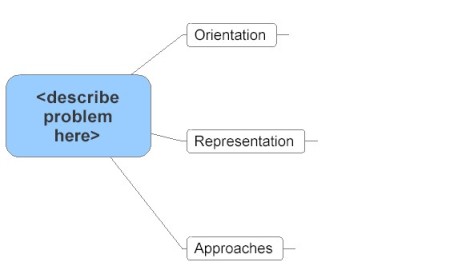Here are some ideas on how to use mind maps to overcome difficulties with math problems.
As described elsewhere on this blog, we will use two mind maps:
- a “problem map” for dealing with the given problem, and
- one or more “tool maps”. Tool Maps are collection of tools for solving math problems. Here are some examples.
For the problem map, we use a sheet of large size (A3 works well) and the following layout and template:

What can we do with the branches in this map?
Here are some basic ideas.
Orientation:
- Look at an example.
- Make a table, chart cases systematically.
- Draw a figure.
Representations:
- Collect ways of representing the problems (algebraic, geometric or graphic, algorithmic…)
Choosing a clever representation is often vital for finding a solution. Don’t neglect this step.
Approaches:
- Collect approaches how to tackle the problem (e.g. contradiction, induction, looking at extreme elements…)
These approaches are just seminal ideas, not entire plans of a solution.
You can work in a brainstorm fashion, so list even approaches that look less promising.
For each of these template branches, you can use ideas from the tool maps.
Here is an easy example:

Working wih the template is fairly straigthforward when you start examining a problem.
But sooner or later difficulties and obstacles will probably appear.
Here are some snapshots from an interior monologue:
- “This seems too complicated.”
- “I don’t want to go into masses of single cases. There must be a more elegant way.”
- “I have no idea how to tackle this.”
- “All approaches have failed, and I have no idea what to do next.”
- “This approach looks promising, and the first steps feel right, but what now?”
- “I’m confused! I’d like to change a single item, but it’s connected with all the others.”
To make things (just a bit) more systematic, here is a tool map showing typical difficulties and some possible remedies.

(Again, the SCAMPER mnemomic is taken from Ron Hale-Evan’s “Mind Performance Hacks”, was developed by Bob Eberle and first published in Michael Michalko’s “Thinkertoys”.)
How to apply these ideas practically?
Here is a simple idea:
Add a subbranch to the approach you are focusing on. If you like, you can label this branch “O” for “obstacle”.
Describe the difficulties with this approach. If you like, use the collection of difficulties above. If it helps, use it as a starting point for your personal “First Aid” tool map.
Then add ideas on how to overcome these difficulties, using the remedies suggested above.
Here is an example:




 Posted by thomasteepe
Posted by thomasteepe